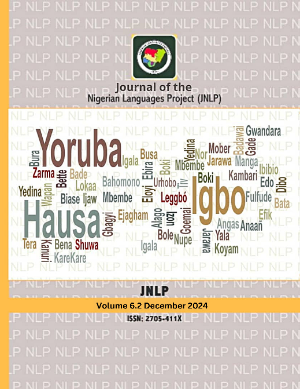Tonal processes in Anaañ
DOI:
https://doi.org/10.60787/jnlp.v6i2.74Keywords:
Tone, words, language, Anaan̄, phonological processesAbstract
The concept of tone is a common phonological feature among the Lower Cross languages,
though its manifestation varies across individual languages. This paper examines the tonal processes in Anaan̄, focusing on how tones interact with vowels across different phonological environments. The primary objectives of the study are to identify the tonal patterns in Anaan̄, investigate the tonal processes involved, and explore the factors that trigger these processes. The study is anchored in the autosegmental framework proposed by Goldsmith (1976), which emerged in response to the limitations of classical generative phonology. Data were collected through participant observation, semi-structured interviews, informal conversations with native speakers of Anaan̄, and relevant secondary sources. Findings reveal that tonal processes are fundamental suprasegmental elements that contribute significantly to meaning in Anaan̄. The study identifies several tonal processes, including tone raising, tone lowering, tone copying, tone polarization, tone displacement, floating tones, downstep, downdrift, tone deletion/delinking, tonal linking/relinking, and tonal upstep.
References
Ameze, I. (2020). Tone and Tone Processes in Edo Language. Mubi Journal of Languages. Vol.1, 1. 1-15.
Anagbogu, P., Mbah, B., & Eme, C. (2010). Introduction to Linguistics (2nd edition). Anambra State: Amaka Dreams Ltd. (11, 3-46).
Clark, J., Yallop, C. & Fletcher, J. (2007).An Introduction to Phonetics and Phonology (3rd edition). London: Blackwell Publishers
Connell, B (1994). The Lower Cross Languages. A Prolegomena to The Classification of The Cross River Language of Latest African Languages, Journal of West African Languages 24.3-46.
Crystal, D. (1992). Encyclopedia of Language and Linguistics. Oxford: Blackwell.
Cruttenden, A. (1997). Intonation. Cambridge: Cambridge University Press.
Essien, O. (2005). The So-called Downstepped Tone in Ibibio. In Ndimele O.M. (ed.) Globalization: The Study of Languages in Africa. Port Harcourt: Grand Orbit Communications & Emhai Press. 343-352.
Essien, O. (2010). Vital Aspects of Linguistics: M&J Educational Books, Mile 1. Diobuo, Port Harcourt, Nigeria.
Ette, E. U. (2007) Anaan̄ heritage Preservation, Retrieved. May 23rd, 2012 from
Http://www.Anaan̄heritage.ng.
Ette, E. U. (2009). Anaan̄Wisdom. Tools for Post-Modern Living. Bloomington: Xibis Press.
Ette, E. U. (2010). The Scientific Enterprise, Identity and Power in Africa: The Case of Anaan̄ of Nigeria. International Journal of Science in Society, (4) 175-191.
Ewen, J. & Hulst, H. (2001). The Phonological Structure of Words: An Introduction. Cambridge, CUP.
Eyakndue, I. (2023). A Phonological Description of Vowels and Tones in Anaañ Word Structure: Ph.D. Dissertation. Department of Linguistics and Communication Studies, University of Calabar, Calabar. Cross River State, Nigeria.
Eyakndue, I. & Ogar, N. (2023). Phonological Analysis of Anaan̄ Compound Names:
International Journal of Humanitatis Theoreticus, Vol.7, 111-122.
Eyakndue, I. (2024). Vowel lengthening in Anaan̄. Journal of the Linguistic Association of Nigeria, 27(17amp; 2), 117-138
Faraclass, N.G (1989). Cross River, In Bendor Samuel (Ed). The Niger Congo language: A
classification and description of Africa's largest language family. Lanham, MD:
University Press of America, 377-399.
Goldsmith, J. A (1976). Autosegmental Phonology. Ph.D. Dissertation, MIT. New York:
Garland Press.
Goldsmith, J. A. (1990). Autosegmental and Metrical Phonology. Oxford: Basil Blackwell.
Hyman, L.M. (1975), Phonology: Theory and Analysis, New York: Holt: Rinehart & Winston.
Katamba, F. (1989). An Introduction to Phonology. Longman Incorporation. New York.
Katamba, F. (1993) Morphology. New York. Palgrave Publishers.
Leben, W. (1971). Suprasegmental and Segmental Representation of Tone Studies in African Linguistics Supplement, 2, 83-200.
McGregor, W. B. (2009). Linguistics: An Introduction. New York: Continum International
Publishers.
Obute, S., Eyakndue, I. & Otun, J. (2019). Language use and Undemocratic Governance in
Contemporary Nigeria: International journal of Integrative Humanism, Ghana, Vol. 11, No.2, 131-138.
Oden, D. (1980). Associative tone in Shona. A Journal of Linguistics Research,1, 37-52.
O’Graddy, W., Archibald, J. and Katamba, F. (2011). Contemporary linguistics in introduction. Pearson Education Limited; Edinburgh gate. England.
Ojobo, A. (2013). Tonal Phonology of Yala: a Ph.D. Dissertation. Department of Linguistics and Communication Studies, University of Calabar, Calabar. Cross River State, Nigeria.
Pulleyblank, D. (1986). Tone in Lexical Phonology. Dordrecht: D Reidel. Pp xii – 249
Udoh, I. and Okon, B. (2008). The Languages of the Niger Delta Region of Nigeria. Lagos, Nigeria. Concept Publications Limited.
Udondata, J. (2006). A grammar of Anaan̄ language, Ikot Ekpene: Patom graphics.
Udoh, I. (2003). An Introduction to Phonemic Analysis. Lagos: Concept Publication Ltd.
Udoh, I.; Anyanwu, O.; & Osuagwu, E. (2019.) Fundamentals of Linguistics. Friutied Publication LTD. Uyo. Nigeria.
Umoren, E. (1997). Anaan̄ Cultural Identity Strategy for its Preservation. Afe Journal of Minorities.
Urua, E. (2001). The Tone System of Ibibio. Typology of African Prosodic Workshop: Bielefeld University, Germany.
Urua, E. (2007). Ibibio Phonetics and Phonology. Port Harcourt: Emhai press
Welmers, N.E. (1959). Tonemic, Morphotonemic and Tonal Morphemes. Los Angeles: University of Califonia.
Williams, E. (1976). Underlying Tone in Margi and Igbo Linguistics Inquiry. 7; 463-84
Yip, M. (2002). Tone. Cambridge: Cambridge University Press.
Yusuf, O. (2007); Basic Linguistics for Nigerian Languages Teachers. Linguistic Association of Nigeria, Grand Orbit Communications Ltd, and Emai Press. Port Harcourt.











